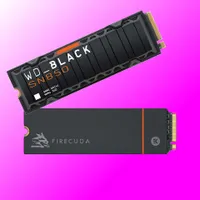Excess stock and poor SSD sales look set to pull flash memory prices down by up to 10%
It's the same old story, folks.

Anyone who has been keeping a close eye on SSD prices will know that they've always followed a neverending cycle of going up-up-up, then down-down-down, before climbing back up. Right now we're at the zenith of this pattern but thanks to an excess of production and lower-than-expected demand, it's expected that the price rollercoaster will start a period of decline by as much as 15%.
That's according to a new report by Trendforce, a market research and analysis firm, that specialises in all things electronic. It notes that while demand for enterprise-level SSDs has been as high as ever, driven by the explosion in AI computation, the consumer sector has been decidedly uninterested in buying lots of shiny new SSDs.
The distinct lack of interest in client-based AI stuff (aka AI PCs) hasn't helped matters either and Trendforce expects that SSD contract prices will fall between 5 and 10% over the next three months. Every week, we search through all the major retailers for the best prices on the best gaming SSDs and I have to say that given how volatile some models have been, any reduction will be welcome.
However, Trendforce also notes that over the past three months, consumer-grade SSD prices have generally gone up by 8 to 10%, so this reduction will just negate that increase. In other words, we probably won't see cheaper SSDs on shelves just yet.
What should swing matters in our favour, though, is the fact that Trendforce expects an overall decline in contract prices for all NAND flash products, with the exception of server-grade stuff. But even that will only increase by a few percent. Altogether, the excess in flash chips and lower demand should pull wafer prices down, by as much as 15%.
Admittedly that's not a huge drop but it does indicate that we're about to move into a period where NAND flash products (SSDs, memory sticks, phone storage, etc) will all slowly drop in price. That will probably take anywhere between six and nine months to fully come to light, and by then, flash manufacturers such as Samsung and Micron, will ease off on production to decrease wafer inventory more than they already have.
New PCIe 5.0 SSDs should make an appearance in 2025 and it's generally expected that they will run a lot cooler than current models, which all have a tendency to get seriously scorchio when under load. Should that all come to pass, demand will pick back up but thanks to the reduced inventory, prices will then start to rise again.
Keep up to date with the most important stories and the best deals, as picked by the PC Gamer team.
Thus, the neverending cycle of SSD prices will continue for another 12 to 24 months, just as it has ever done. I suppose we should be thankful that solid state storage hasn't gone the way of motherboards and GPUs, which all seem painfully expensive these days. And one doesn't need a hot-snotting Gen5 SSD to enjoy fast load times in a gaming PC; any of the best SSDs around right now are more than good enough.
Best SSD for gaming: The best speedy storage today.
Best NVMe SSD: Compact M.2 drives.
Best external hard drive: Huge capacities for less.
Best external SSD: Plug-in storage upgrades.

Nick, gaming, and computers all first met in the early 1980s. After leaving university, he became a physics and IT teacher and started writing about tech in the late 1990s. That resulted in him working with MadOnion to write the help files for 3DMark and PCMark. After a short stint working at Beyond3D.com, Nick joined Futuremark (MadOnion rebranded) full-time, as editor-in-chief for its PC gaming section, YouGamers. After the site shutdown, he became an engineering and computing lecturer for many years, but missed the writing bug. Cue four years at TechSpot.com covering everything and anything to do with tech and PCs. He freely admits to being far too obsessed with GPUs and open-world grindy RPGs, but who isn't these days?


